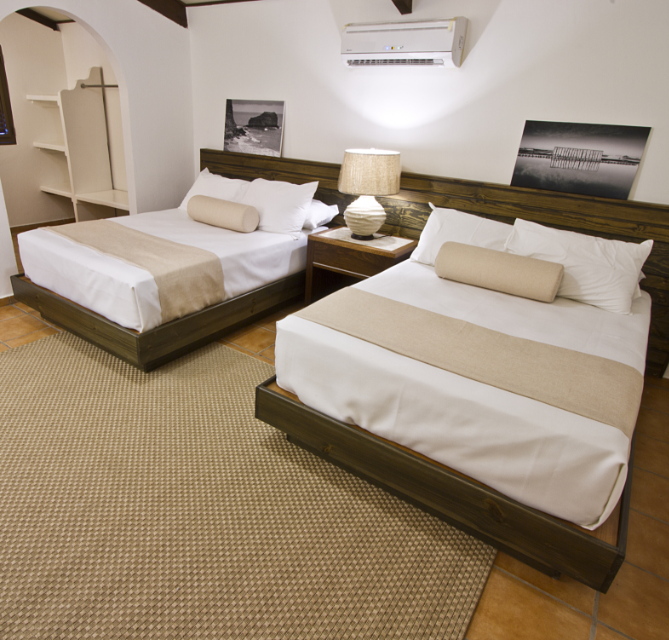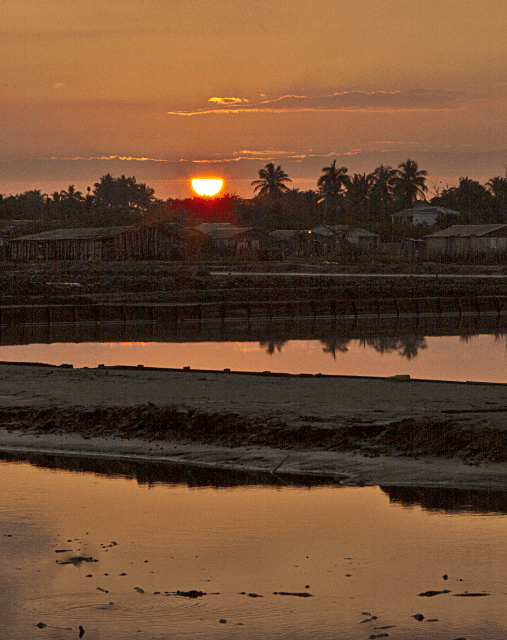The casitas in the garden area accommodate our twelve rooms. Rooms are spacious with contemporary furnishings in soft and warm tones. Images of local landmarks grace the walls and remind us of the essence o where we are.

Deluxe Room Double Bed
With a soft and warm caribbean styled decoration, this room has a double bed, bathroom, air conditioning, ceiling fan, warm water, tv and cable.

Deluxe Room Two Double Beds
With a soft and warm caribbean styled decoration, this room has two doubble beds, bathroom, air conditioning, ceiling fan, water heater, tv and cable.
To celebrate Montecristi each room is named after the sites, local landmarks, flora and fauna that surrounds us.

El Reloj
El reloj de Montecristi is an emblem of the city and a reminder of the economic prosperity experienced during the last quarter of the 19th century.
Built in France by watchmaker Jean Paul Garnier, it was originally located in the French city of Saint-Germain-en-Laye. Upon its purchase by the municipality of Montecristi, it was dismantled and transported by steamboat and train to its current location.
The structure was installed on March 11, 1895 and inaugurated on June 26 of the same year. Standing 96 feet tall, shaped like a champagne bottle, its metal structure stands proudly in the center of town and remains in operation.

El Chivo
The goat is an icon of the northwestern region, where it is very popular and one of the highlights of its culinary traditions.
It is characterized by its special flavor, a result of the local breeding conditions and the presence of wild oregano in its feeding habits.

El Yaque
The Yaque del Norte is the longest river in the Dominican Republic.
Originating in the Cordillera Central, it flows through the Cibao Valley, west of Montecristi and unto Manzanillo Bay.
When Christopher Columbus first saw the river during his first trip to America, he named it Gold River because of the pieces of gold that were found here.

Los Caños
This natural waterway meanders from the city of Montecristi, trough El Morro National Park, and on to the Atlantic Ocean.
Surrounded by mangrove forests, it harbors an abundance of wildlife species including manatee, starfish and mangrove canaries. Its depth ranges from 1.5 to 3.5 m and while its floor is mostly covered by seaweed, there are natural pools with crystal clear water and sandy bottom.

La Granja
When Christopher Columbus drew the first known map of the area, he named this cove La Grange.
It is believed that perhaps it reminded a crew member of the French site with the same name. Its beach extends from Caño Embarcadero on to El Morro, with a few interruptions along the way.

La Pipa
During the colonization period, galleons filled with treasures and merchant goods crisscrossed the route north of Montecristi.
Hundreds of them were stranded in the sand dunes and coral reefs or sunk due to pirate attacks and tropical storms.
With more than two hundred ships lying off the coast of Montecristi, it is customary to name them after the contents of their cargo. Among them we can find the Ship of the Pipes, the Ship of Crystals, the Ship of the Musket Balls and the Ship of the Cannons.

Manglar
The mangrove forests in Montecristi are among the largest in the Dominican Republic. Their extension is equivalent to 40% of the total mangrove coverage in the country.
Mangroves are important ecosystems that provide a natural habitat for many species of flora and fauna, as well as protection against flooding and coastal erosion.

El Morro
El Morro de Montecristi is a natural landmark that rises like a guardian of the ancient city founded by Nicolás de Ovando and baptized San Fernando de Montecristi in honor of King Ferdinand II of Aragon.
Overlooking miles of beautiful untapped coastline, El Morro rises resembling a large flat pot made of clay. From its top, visitors can overlook the stunning bay and Cayos Siete Hermanos.
Bordering its southern edge there is a coastal waterway system with mangroves and lagoons, which is surrounded by a subtropical dry forest with its respective flora and fauna.
It is certainly an enchanting place within a wonderful land, highly ranked by nature lovers who are amazed at the variety and beauty of this miniature continent.

Mariposa
The picturesque yellow butterfly that abounds in the region is a lovely specimen that welcomes you to Montecristi.
Butterflies reflect the state of conservation, diversity and endemism, as well as the respective state of intervention or disturbance of the natural ecosystem. Thus, its abundance in the area highlights its significant environmental attributes.

Salinas
Montecristi is the largest producer of sea salt in the Dominican Republic.
Part of the coastal plain is under sea level and this allows water to flood into the water terraces where salt is still produced in the artisanal tradition.

Siete Hermanos
Cayos Siete Hermanos is a scientific reserve located a few miles northwest off the coast of Montecristi.
These sandy cays harbor coral reefs, marine fauna and migratory birds that breed here during the summer months.
The cays are named Monte Grande, Monte Chico, Tercero, Muertos, Ratas, Arenas and Torurú. An old lighthouse still stands in Cayo Ratas, which served to guide sailors when the route to Montecristi was amongst the busiest in the country.
It is an excellent spot for snorkling, diving and bird watching.

Corales
The coral reefs of Montecristi are recognized as the most extensive, diversified and well preserved in the country.
The reef that extends from Punta de Granja, in El Morro, to Punta Rucia is the largest reef barrier in the country and contains a particular faunal structure different from the rest of the Caribbean.
